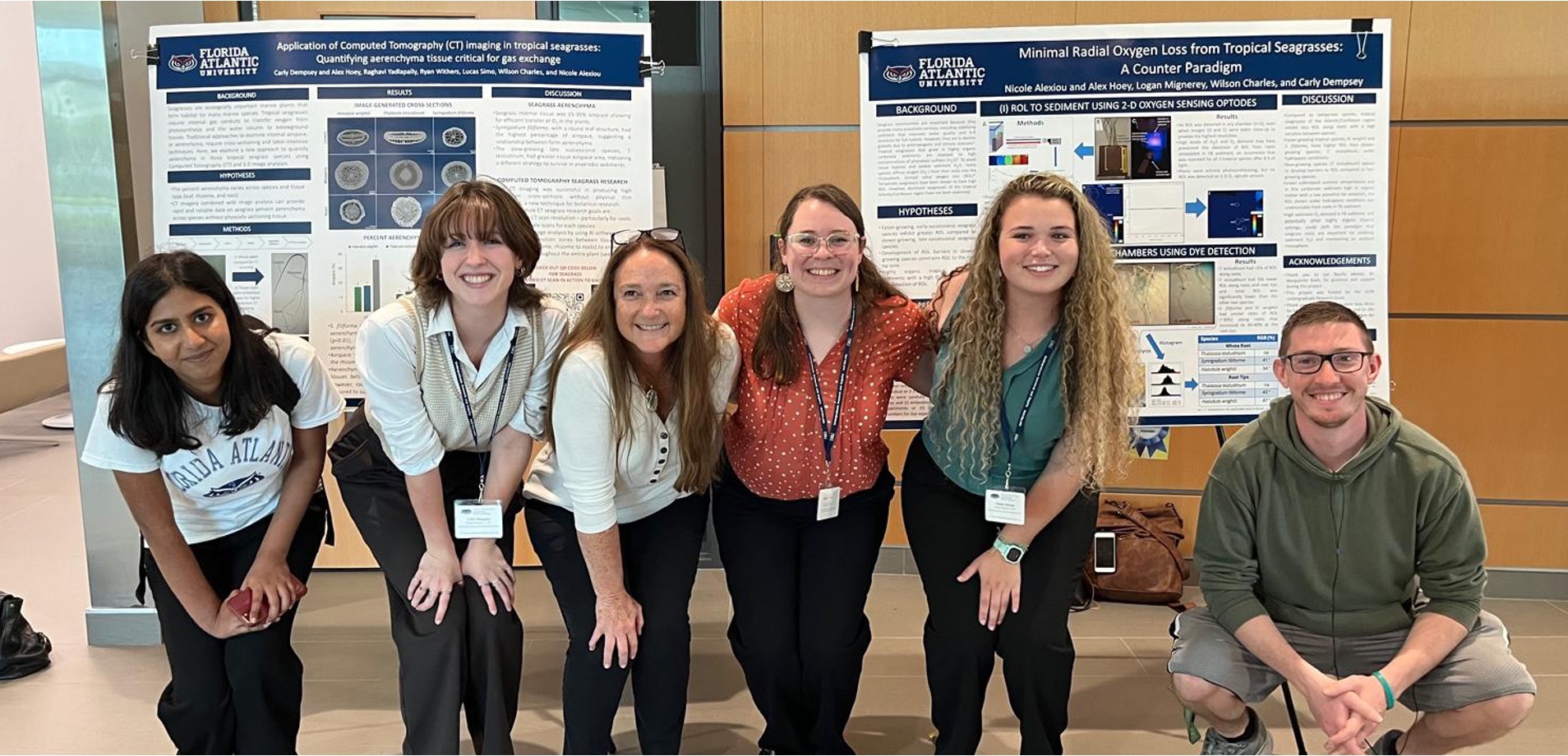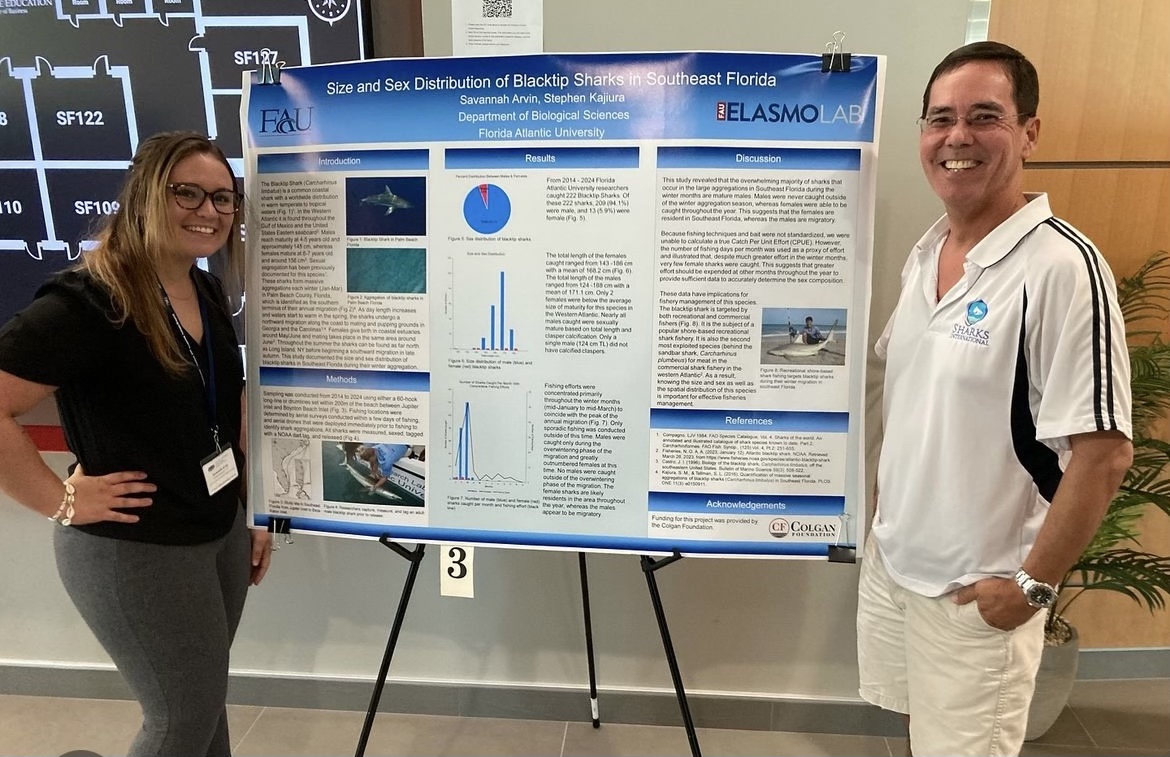
Author: Gael-Lynn Laguerre
Date: April 15, 2024
The responsibilities of Glenn W. & Cornelia T. Bailey Marine SEA Scholars at the FAU Marine Lab fall under many different branches of community outreach. As an ambassador of FAU and the marine sciences, a scholar must confidently inform and communicate with audiences that may have very little to no prior knowledge of the scientific subject. A scholar’s messages can transcend the educational space and move on to provide a communal impact, allowing the public to learn more cool things about marine biology than they ever knew before!
However, while gaining masterful public speaking skills and sharing complex science with the public, two undergraduate SEA Scholars also found the time to conduct and present their own research. On April 5th, Savannah Arvin and Alex Hoey, two undergraduates in this program, earned the opportunity to present their individual research projects at the 14th Annual Undergraduate Research Symposium. Conducting research and presenting those results early in their careers offered these students a chance to grow academically, while gaining problem-solving skills firsthand through fieldwork and laboratory analysis. Each emphasized that while the data acquisition and analyses associated with their projects were very demanding, they both found the experience extremely rewarding.
Alex Hoey and her lab mate Nicole Alexiou presented a study examining the radial oxygen loss (ROL) in tropical seagrasses from Florida Bay. This project was conducted under the supervision of their research advisor, Dr. Marguerite Koch (pictured above with members of her lab). Radial oxygen loss is defined as the diffusion of oxygen out of the plant’s roots and into the surrounding sediment. Hoey, Alexiou, and their other lab collaborators measured this diffusion using oxygen sensors and a blue staining dye to highlight the root characteristics of three seagrass species. Their analysis demonstrated that slower-growing species had lower ROL, potentially allocating more energy to developing barriers to gas exchange than faster-growing species. In an interview, Hoey highlighted the skills she developed in the process of presenting this research, and how becoming competent at communicating what was learned to a general audience was such a beneficial and important accomplishment.
“I have gained a lot of practice in scientific writing and communication by preparing for and presenting at the symposium,” stated Hoey. “It’s a unique experience to take something that feels really complex and be able to explain it to people that are coming to hear all sorts of research.”
Hoey also spoke about how uniquely rewarding the feedback was from such a diverse audience.
“Two of our most frequent questions were: ‘How will this impact seagrass in the future?’, and ‘What are our future research goals?’ To meet people who didn’t have a background in seagrasses before, and who thought of these relevant questions after hearing about our research, is extremely rewarding.”
Hoey, alongside fellow undergraduate Carly Dempsey, also presented a second poster measuring the internal airspace pathways of tropical seagrass species using computed tomography (CT), often termed a CAT scan or a 3D x-ray, which might sound more familiar. These airspaces work as “highways” for oxygen to move inside the plant.
“A lot of hard work by many different people went into each of these projects, which has given us important insights into the collaborative process of research,” said Hoey. Excitingly, Hoey and Dempsey’s poster about these seagrass oxygen “highways” was awarded 1st place in People’s Choice for Marine, Environmental, and Ecological category!
Another SEA Scholar, Savannah Arvin, conducted a study centering on the size and sex of the blacktip sharks seasonally present in southeastern Florida waters. Arvin, working under the supervision of Dr. Stephen Kajiura, analyzed eight years of field data. She displayed data in three graphs that illustrated the sexual composition of the blacktip shark migratory schools present in our coastal waters. The data showed that most of that population consisted of male sharks, a result that, while not anticipated, was not entirely unknown:
“Black tip sharks have been documented to participate in what is called sexual segregation,” stated Arvin. “The males are the ones that migrate, and the females are typically residents in a more restricted area.”
Arvin explained she had initial feelings of doubt when conducting research as an undergraduate student, but slowly built up her confidence as she continued working on the data analyses.
"When I first started in research, I felt intimidated – like I didn't know anything compared to my professor or his graduate students. It felt like the pressure was on! But over time, my knowledge has grown, and I have been able to genuinely understand my research topic and our conclusions. As I graduate this semester, I feel like I've done my part and done what I can for my research.”
In summary, the benefits of conducting research as an undergraduate student are endless! From immersive exploration and skill development to achieving academic and personal fulfillment, the opportunity to explore the art of scientific inquiry allows student researchers to grow and gain confidence. It also allows undergraduates like Alex Hoey and Savannah Arvin to embody a spirit of discovery and conservation, aiding in their professional development as future marine biologists! Great job, GW&CTB Marine SEA Scholars!

|
| Savannah Arvin and Dr. Stephen Kajiura smile next to their research poster at the undergraduate symposium. |